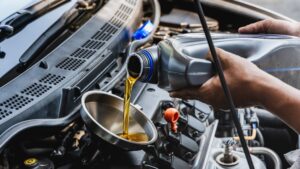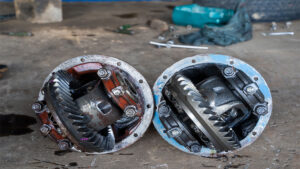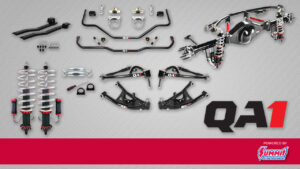What Is the Difference Between Street and Race Bearings?
Engine bearings are available for every reason and possible application. Whether it’s your daily rig or a funny car, Team Summit NHRA Funny Car driver Tim Wilkerson and Frankie Forman from Engine Power can answer the questions you might have been wondering.
Internal combustion engines’ main and rod bearings are designed to “bear up” under tremendous stress. If you’re in your daily driver, you understand that longevity is the objective. You want your bearing to last hundreds of thousands of miles with minimal maintenance.
Race engines on the other hand have a higher level of maintenance and shorter service life. In order to survive, it must withstand high heat, rpm, and cylinder pressures that reach 1,000 psi or more, as well as using thin racing oil and even smaller, narrowed bearings.
How Bearings Work
Bearings function under the principle of Hydrodynamic Lubrication, which is defined as a lubrication regime that occurs between sliding surfaces when a full film of oil supports and creates a working clearance. Direct metal-to-metal contact between rotating parts shouldn’t happen because of the thin protective oil film between two surfaces. These form a hydrodynamic wedge capable of supporting large loads.
On occasion, some metal-to-metal contact will occur, and for the daily driver, it’s during the start-up and shutdown phase. For a hot-rod or race car, it can occur because of bending loads, shaft flex, and deflection caused by g-forces, high loads, and inertia. This is where your bearings do their job – it takes the brunt of the occasional metal-to-metal, high-friction contact when the oil film momentarily breaks down. Bearings allow the engine to remain operational without sustaining any damage.
Bimetal and Trimetal Bearings
There are two different means of bearing constructions produced today – bimetal & trimetal. Today’s bimetal designs consist of two separate materials – steel back and a layer of bearing material. Since the ’90s, the overlay has consisted of a hard aluminum alloy bonded to the steel, which comes stock on almost all of today’s production cars.
Trimetal, which refers to “three-layer designs,” has a steel back with a copper-lead intermediate layer. The top layer consists of varying materials. These are the standard of high-performance, racing, and a select few high-end cars, such as the supercharged Corvette.
The trade-off between these two bearings is the resistance to extreme loads versus expected service length. Modern aluminum bimetal bearings are hard, so it’ll wear slowly for its lifetime of moderate service. However, on high-power engines subject to twisting cranks and high horsepower, you want to avoid a hard bearing.
In this case, a softer, more forgiving trimetal bearing comes into play. You don’t need your high-performance car to go hundreds of thousands of miles on one engine, but it must withstand metal-to-metal contact more frequently.
Why Do Bearings Wear Out?
Bearings typically wear out because of other engine functions, not so much the bearings themselves. It makes it impossible to predict when they’ll fail or how long they’ll last. Under ideal conditions, bearings will last indefinitely. However, they consist of lead compounds and copper, and they’re subject to various weaknesses.
The primary factor when it comes to ensuring the life of a bearing is lubrication. As long as there’s a steady flow of clean oil, the bearings will continue to to move along just fine. If your oil is dirty or a steady supply is cut off, you’re subject to problems.
Other common reasons bearings can wear out include:
- Pressure
- Excessive heat (if your oil doesn’t provide sufficient lubrication and/or cooling)
- Corrosion or etching caused by exposure to acid or other chemicals in contaminated oil
- Exposure to dirt or debris in the oil, which scratches the bearings and engine parts they contact
- Drying out caused by oil blockage, leakage, or poor circulation (in some cases caused by incorrectly sized bearings)
- metal-on-metal contact (caused by dryness from poor oil flow)
What Are the Benefits of a Coated Bearing?
The benefits of a coated bearing are immense, and they provide intermittent dry lubrication. Coated bearings provide extra protection against dirt, dust, insufficient lubrication, and have a low coefficient of friction. A thin coat on the bearing offers chemical protection, chemical resistance, and reduced drag and friction.
Other benefits include:
- Increased lubricity
- Corrosion protection
- Oil and fuel resistant
How to Choose the Right Bearing
When it comes to the engine of your car, it’s easy to think that a bearing is a bearing. However, based on everything we’ve mentioned above, there are differences to take into consideration. Bearings are not a one-size-fits-all part.
Before determining which bearing you’ll choose, ask yourself these questions – will your engine experience short bursts of medium to high loads, or will it be exposed to extreme loads for a longer duration? Will your engine operate in a dirty or clean environment? Knowing the answer will help you determine the type of bearing based on the application.
For example, an engine used in drag racing will be exposed to an environment with fewer airborne contaminants than a race car on a dirt track. The engine at a dirt track should use bearings with more embeddability to ensure dirt stays out of the engine oil and does not cause damage to the crankshaft.
When building a race engine that delivers higher horsepower and torque, you’ll need a different bearing to handle the increased loading. The bearings must be made of stronger materials so they handle the additional horsepower without experiencing fatigue.
The primary properties engine bearings should possess include:
- Load Capacity: is the maximum value of cycling stress bearings can withstand without causing fatigue cracks after an infinite number of cycles.
- Compatibility: is the ability of the bearing to resist physical joining with the journal material when they come in direct contact.
- Water Resistance: is the ability of your bearing to maintain its dimensional stability under the conditions of mixed lubrication regime and foreign particles circulating with lubricant.
- Conformability: is the ability of your bearing to absorb small particles that circulate in the lubricating oil.
- Corrosion Resistance: the ability of your bearing to resist chemical attacks caused by lubricants.
- Cavitation Resistance: the ability of your bearing to withstand impact stresses caused by collapsing cavitation bubbles that form as a result of localized and sharp drops of pressure in the lubricant.
How to Properly Install the Bearing
When you choose the bearing for your specific application, there are certain criteria to follow. At any time during the installation, everything must remain clean. When placing the bearings in the engine, they should be positioned in the bearing saddles while dry. You should follow this up with lubrication before crankshaft installation. All bolt threads should be cleaned with a thread chaser and slightly lubricated during assembly. Make sure the engine is primed before it’s started.









